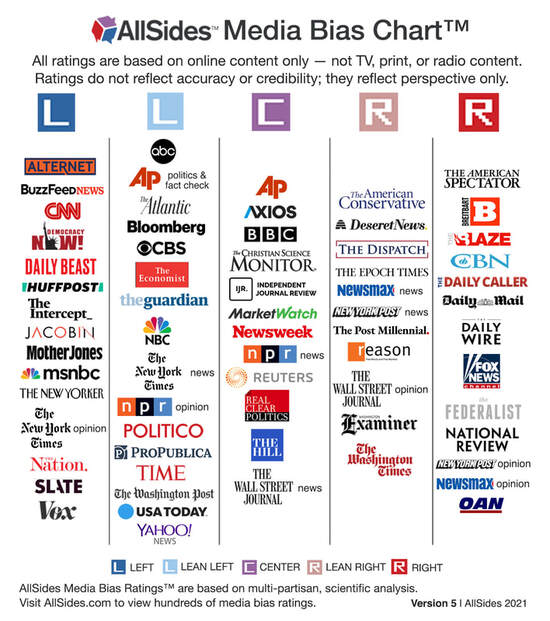Combatng Fake News in the Digital Age
- A Matter of Facts: the Value of Evidence in an Information Age by Laura Millar - PD 025.524 MIL
- Combating Fake News in the Digital Age by Joanna M. Burkhardt - PD 020 BUR
- Fact vs Fiction: Teaching Critical Thinking Skills in the Age of Fake News by Jennifer LaGarde - PD 370.15 LAG
- Fake News and Alternative Facts: Information literacy in a Post-Truth Era by Nicole A. Cooke - PD 306.42 COO
- Fake News: Separating Truth from Fiction by Michael Miller - : 070.43 MIL
Five Types of media
- Broadcasting - television and radio
- Print Media - newspapers, magazines, books, advertisements, and posters
- Movies and Theatrical Performances
- Internet - news sources and social media
- Games - Electronic and online
essential media literacy skills
- Access
- Analyze
- Evaluate
- Create
- Act
What is disinformation?
- Fake News - News that has been entirely fabricated or made up.
- Misinformation - Information that is simply incorrect.
- Disinformation - Involves the intent to deceive or mislead.
- Propaganda - Disinformation with an explicit or implicit political agenda.
Allsides Media bias chart
types of misformation or disinformation
- Fabricated content - Completely false content
- Manipulated content - Content that includes distortions of genuine information or imagery — a headline, for example, that is made more sensationalist to serve as "clickbait."
- Imposter content - material involving impersonation of genuine sources — by using the branding of an established news agency, for instance.
- Misleading content -Information presented in a misleading way — by, for example, presenting comment as fact.
- False context of connection - Factually accurate content that is shared with false contextual information — for example, a headline that does not reflect the content of an article.
- Satire or parody - Humorous but false stores presented as if they are true. Although this isn't usually categorized as fake news, it may unintentionally fool readers.
- Deepfake - Video, audio or images that have been altered with artificial intelligence software to make it seem as if a real person said or did something they didn't actually say or do. The term "deepfake" is a combination of the words "deep learning" (by A.I.) and "fake."
How do i know if it's disinformation?
Andrea Bellemare - CBC News - Jul 05, 2019:
- Does the story seem too good (or bad) to be true?
- Does it seem to confirm stereotypes about a group of people?
- Does it seem to confirm my beliefs?
- Are the details in the story thin or unavailable?
- Does the body of the story match the headline or tweet?
- When was the story published? Is it new? If it's a few years old, why is it circulating now?
- Does the story have a named writer or producer?
- Does the video have a named producer or editor?
- Does the person appearing in the video have a real name or a nickname?
- Have I heard of this organization before?
- What do I know about this organization?
- Does this organization have contact information? What happens when I try to contact it?
- Does this organization have reporters and writers who can be found on social media? Can I see their bylines on the organization's website?
- What is the domain name (web address) of the website? Have I heard of it before? Can I look it up? Does it sound like the address of a similar website with a different ending?
- Can I find another source that confirms this information? Can I find one that counters it?
Media Manipulation
- Media Manipulation Techniques:
- Trolling
- Exploiting emotional language
- Amplifying the reach and popularity of certain messages
- Creating and spreading conspiracy theories
- Polarizing audiences
- Mastering the Art of Disinformation:
- Impersonation - Impersonating someone else and disguising yourself as a credible news source can be highly effective.
- Emotion - Playing to a people's emotions (fear, anger, or compassion) can be a great tool for spreading your message.
- Polarization - By finding existing grievances and blowing them up, you can drive people apart and make them think a story is much more important than it really is.
- Conspiracy - You can use people's desire for the "truth" to lure them into your band of followers.
- Discredit - Is someone attacking your credibility? Strike back! Don't apologize, don't play nice,, and above all: don't retreat!
- Trolling - Trolling is trying to evoke an emotional response such as anger, irritation, or sadness. Don't hold back: your opponent's tears are your followers' mead!
- Breaking Harmony Square: A game that “inoculates” against political misinformation
- Play Harmony Square - the election game
- Bad News info sheet for educators
- Play Bad News - from fake news to chaos

